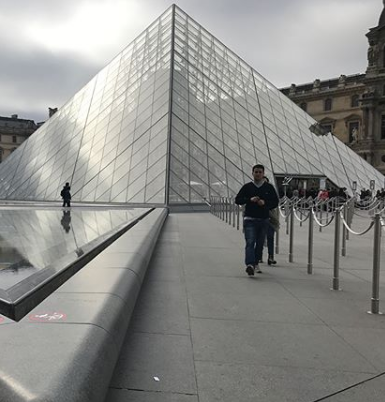the world's largest art museum and a historic monument in Paris, France. A central landmark of the city, it is located on the Right Bank of the Seine in the city's 1st arrondissement (district or ward). Approximately 38,000 objects from prehistory to the 21st century are exhibited over an area of 72,735 square metres (782,910 square feet). The Louvre in 2016 was the world's most visited art museum, receiving 7.3 million visitors.

The museum is housed in the Louvre Palace, originally built as a fortress in the late 12th century under Philip II. Remnants of the fortress are visible in the basement of the museum. Due to the urban expansion of the city, the fortress eventually lost its defensive function and, in 1546, was converted by Francis I into the main residence of the French Kings. The building was extended many times to form the present Louvre Palace. In 1682, Louis XIV chose the Palace of Versailles for his household, leaving the Louvre primarily as a place to display the royal collection, including, from 1692, a collection of ancient Greek and Roman sculpture. In 1692, the building was occupied by the Académie des Inscriptions et Belles Lettres and the Académie Royale de Peinture et de Sculpture, which in 1699 held the first of a series of salons. The Académie remained at the Louvre for 100 years. During the French Revolution, the National Assembly decreed that the Louvre should be used as a museum to display the nation's masterpieces.

During the French Revolution the Louvre was transformed into a public museum. In May 1791, the Assembly declared that the Louvre would be "a place for bringing together monuments of all the sciences and arts". On 10 August 1792, Louis XVI was imprisoned and the royal collection in the Louvre became national property. Because of fear of vandalism or theft, on 19 August, the National Assembly pronounced the museum's preparation as urgent. In October, a committee to "preserve the national memory" began assembling the collection for display.

The museum opened on 10 August 1793, the first anniversary of the monarchy's demise. The public was given free access on three days per week, which was "perceived as a major accomplishment and was generally appreciated". The collection showcased 537 paintings and 184 objects of art. Three quarters were derived from the royal collections, the remainder from confiscated émigrés and Church property (biens nationaux). To expand and organize the collection, the Republic dedicated 100,000 livres per year. In 1794, France's revolutionary armies began bringing pieces from Northern Europe, augmented after the Treaty of Tolentino (1797) by works from the Vatican, such as Laocoön and His Sons and the Apollo Belvedere, to establish the Louvre as a museum and as a "sign of popular sovereignty"

The Musée du Louvre contains more than 380,000 objects and displays 35,000 works of art in eight curatorial departments with more than 60,600 square metres (652,000 sq ft) dedicated to the permanent collection. The Louvre exhibits sculptures, objets d'art, paintings, drawings, and archaeological finds. It is the world's second most visited museum, averaging 15,000 visitors per day, 65 percent of whom are foreign tourists.

The Louvre is involved in controversies that surround cultural property seized under Napoleon I, as well as during World War II by the Nazis. During Nazi occupation, thousands of artworks were stolen. But after the war, 61,233 articles of more than 150,000 seized artworks returned to France and were assigned to the Louvre's Office des Biens Privés. In 1949, it entrusted 2,130 unclaimed pieces (including 1,001 paintings) to the Direction des Musées de France in order to keep them under appropriate conditions of conservation until their restitution and meanwhile classified them as MNRs (Musées Nationaux Recuperation or, in English, the National Museums of Recovered Artwork). Some 10% to 35% of the pieces are believed to come from Jewish spoliations and until the identification of their rightful owners, which declined at the end of the 1960s, they are registered indefinitely on separate inventories from the museum's collections.





Hi! I am a robot. I just upvoted you! I found similar content that readers might be interested in:
https://en.wikipedia.beta.wmflabs.org/wiki/Louvre
Is a small summary.
For people to understand
Thanks for sharing... Love it.
Beautiful